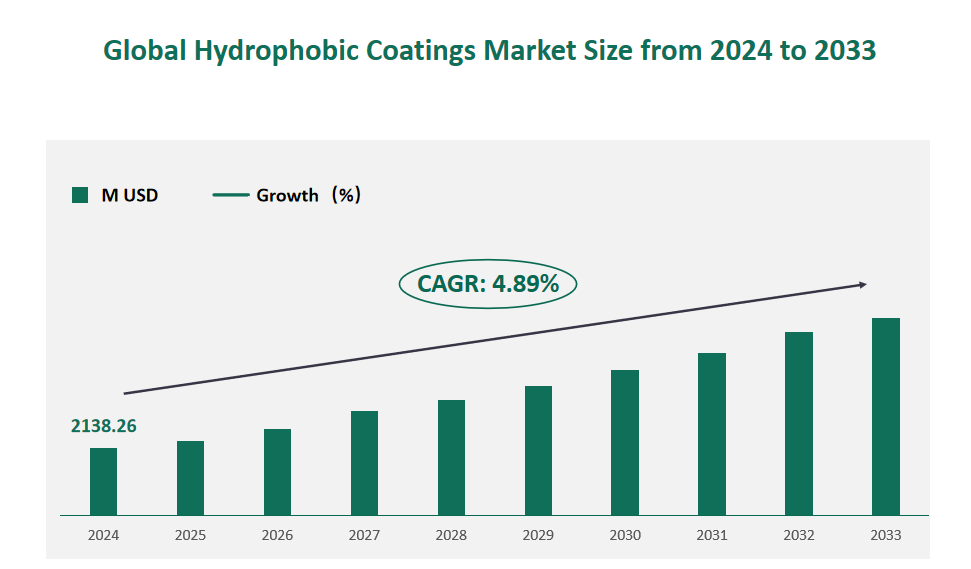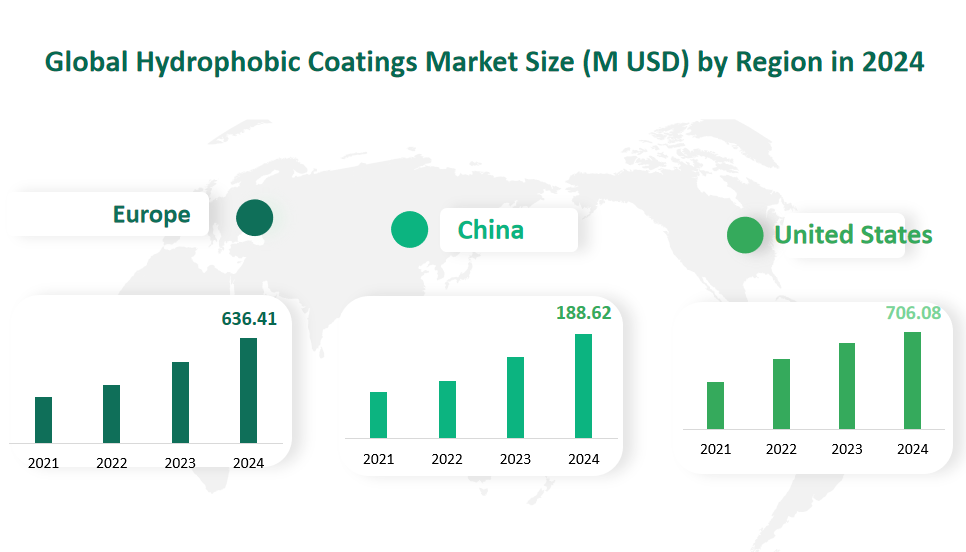1 Global Hydrophobic Coatings Market Size (Value) and CAGR (2024-2033)
In 2024, the global Hydrophobic Coatings market was valued at USD 2138.26 million, with a CAGR of 4.89% from 2024 to 2033.
Hydrophobic coatings are specialized materials designed to provide surfaces with water-repellent properties. These coatings are engineered to reduce the surface energy of materials, making it difficult for water to adhere to them. As a result, hydrophobic coatings offer a range of benefits, including resistance to corrosion, self-cleaning capabilities, and enhanced durability.
Figure Global Hydrophobic Coatings Market Size (M USD) and CAGR 2024-2033

2 Hydrophobic Coatings Market Drivers
The hydrophobic coatings market presents a multitude of opportunities driven by various factors across different industries. One of the primary opportunities is the development of the construction industry. As urbanization accelerates, especially in emerging economies, the demand for durable and low-maintenance building materials is on the rise. Hydrophobic coatings, with their ability to protect surfaces from water damage, corrosion, and environmental elements, are becoming increasingly essential. These coatings not only extend the lifespan of buildings but also reduce maintenance costs, making them highly attractive to construction companies and property owners.
Another significant opportunity lies in the automotive and aerospace sectors. Both industries are continuously seeking materials that enhance performance and durability while reducing maintenance needs. Hydrophobic coatings can protect vehicles and aircraft from water damage, UV degradation, and other environmental factors, thereby improving their longevity and efficiency. The growing demand for lightweight and fuel-efficient vehicles further supports the adoption of hydrophobic coatings, as these coatings can help reduce the overall weight of the vehicle while maintaining structural integrity.
The growth of the renewable energy sector also presents a notable opportunity. Photovoltaic panels, for instance, can benefit from hydrophobic coatings that prevent dirt accumulation and improve energy efficiency. Similarly, wind turbines can be protected from corrosion and wear, ensuring optimal performance over their operational lifespan. This alignment with the renewable energy sector is particularly timely, given the global push towards sustainable energy solutions.
3 Hydrophobic Coatings Market Restraints
Despite the promising opportunities, the hydrophobic coatings market also faces several challenges that could impact its growth trajectory. One of the primary challenges is the fluctuation in raw material prices. The cost of raw materials, such as polysiloxanes and fluoropolymers, is influenced by global economic conditions and supply-demand dynamics. These fluctuations can significantly impact production costs, reducing profit margins and making it difficult for manufacturers to maintain stable pricing. As a result, companies must constantly monitor and manage their supply chains to mitigate these risks.
Another significant challenge is the loss of core technical staff and technology. The hydrophobic coatings industry is highly technical, requiring specialized knowledge and expertise. The loss of key technical personnel or proprietary technology can severely impact a company’s ability to innovate and maintain a competitive edge.
Regulatory and environmental compliance also poses a challenge. As environmental regulations become stricter, manufacturers must ensure that their products meet the required standards. This may involve investing in research and development to create more environmentally friendly formulations, which can be costly and time-consuming.
4 Global Hydrophobic Coatings Market Size and Share by Type in 2024
Polysiloxanes are a type of polymer with repeating Si-O bonds as the main chain and organic groups directly connected to the silicon atom. These coatings are known for their excellent thermal stability, chemical resistance, and flexibility. In 2024, the revenue generated by polysiloxanes is projected to be 512.59 million USD. Polysiloxanes are widely used in applications such as building and construction, where their durability and resistance to environmental factors make them ideal for protecting surfaces from moisture and corrosion. They are also used in the automotive industry to provide a protective layer that enhances the longevity of vehicle components.
Fluoro Alkylsilanes (FAS) are known for their low surface energy and excellent hydrophobic and oleophobic properties. These coatings are highly effective in repelling water and oils, making them ideal for applications where surface protection and easy cleaning are crucial. In 2024, the revenue from Fluoro Alkylsilanes is expected to reach 504.66 million USD. They are commonly used in precision optics, eyewear, and electronics, where their ability to prevent fogging and reduce dirt accumulation is highly valued. For example, eyewear coated with Fluoro Alkylsilanes maintains clarity and reduces the need for frequent cleaning.
Fluoropolymers are another significant type of hydrophobic coatings. These coatings are characterized by their exceptional resistance to chemicals, high thermal stability, and non-stick properties. In 2024, the revenue from fluoropolymers is projected to be 440.33 million USD. Fluoropolymers are used in a variety of applications, including aerospace, marine, and industrial coatings. Their ability to repel water and resist wear makes them ideal for protecting aircraft surfaces and marine structures from corrosion and biofouling.
Table Global Hydrophobic Coatings Market Size and Share by Type in 2024
Type | Market Size (M USD) 2024 | Market Share 2024 |
Polysiloxanes | 512.59 | 23.97% |
Fluoro Alkylsilanes | 504.66 | 23.60% |
Fluoropolymers | 440.33 | 20.59% |
Others | 680.68 | 31.83% |
5 Global Hydrophobic Coatings Market Consumption (Tons) and Share by Application in 2024
Building & Construction: This sector is the largest consumer of hydrophobic coatings, with an expected consumption of 18,578 tons in 2024. Hydrophobic coatings are used to protect building surfaces from water damage, corrosion, and environmental elements. They extend the lifespan of structures and reduce maintenance costs, making them highly valuable in the construction industry.
Automotive: The automotive industry is another significant consumer, with an expected consumption of 14,124 tons in 2024. Hydrophobic coatings are used to protect vehicle exteriors from water, UV degradation, and other environmental factors. They also enhance the durability and appearance of vehicles, contributing to their overall value.
Aerospace: The aerospace sector is expected to consume 2,922 tons of hydrophobic coatings in 2024. These coatings protect aircraft surfaces from rain, corrosion, and other environmental factors, ensuring the longevity and safety of aircraft.
Marine: The marine industry is expected to consume 4,924 tons of hydrophobic coatings in 2024. These coatings protect marine structures and vessels from water damage, biofouling, and corrosion, enhancing their durability and performance in harsh marine environments.
Photovoltaics: The photovoltaic sector is expected to consume 3,793 tons of hydrophobic coatings in 2024. Hydrophobic coatings are used to protect solar panels from dirt accumulation and moisture, enhancing their efficiency and longevity.
Eyewear: The eyewear industry is expected to consume 4,983 tons of hydrophobic coatings in 2024. These coatings prevent fogging and reduce dirt accumulation on lenses, enhancing clarity and reducing the need for frequent cleaning.
Precision Optics: The precision optics sector is expected to consume 3,152 tons of hydrophobic coatings in 2024. These coatings protect optical components from moisture and environmental damage, ensuring their performance and longevity.
Table Global Hydrophobic Coatings Market Consumption (Tons) and Share by Application in 2024
Application | Market Consumption (Tons) 2024 | Market Share 2024 |
Building & Construction | 18578 | 31.36% |
Automotive | 14124 | 23.84% |
Aerospace | 2922 | 4.93% |
Marine | 4924 | 8.31% |
Photovoltaics | 3793 | 6.40% |
Eyewear | 4983 | 8.41% |
Precision optics | 3152 | 5.32% |
Other | 6760 | 11.41% |
6 Global Hydrophobic Coatings Market Size by Region in 2024
United States: The United States is expected to generate a revenue of 706.08 million USD in 2024. The market is driven by the construction and automotive industries, which are significant consumers of hydrophobic coatings. The United States also benefits from a robust research and development infrastructure, which supports the continuous innovation and improvement of hydrophobic coatings.
Europe: Europe is expected to generate a revenue of 636.41 million USD in 2024. The European market is characterized by strong demand from the automotive and aerospace industries. European countries, particularly Germany and the UK, are known for their advanced manufacturing capabilities and high demand for high-performance coatings. The region also benefits from stringent environmental regulations, which drive the adoption of eco-friendly and durable coatings.
China: China is expected to generate a revenue of 188.62 million USD in 2024. The Chinese market is rapidly growing, driven by the expansion of the construction and automotive industries. China’s economic growth and urbanization are significant factors contributing to the increased demand for hydrophobic coatings. Additionally, China’s focus on renewable energy, particularly photovoltaics, is driving the adoption of hydrophobic coatings in the energy sector.
Figure Global Hydrophobic Coatings Market Size by Region in 2024

7 Major Players in Global Hydrophobic Coatings Market
7.1 BASF
Company Profile
BASF SE is a leading chemical company with a global presence. Established in 1865, BASF operates in six segments: chemicals, plastics, performance products, functional solutions, agricultural solutions, and oil and gas. The company is headquartered in Germany and has manufacturing bases across Europe. BASF offers a wide range of products for various industries, including hydrophobic coatings designed to protect surfaces from water and environmental damage.
Business Overview
BASF’s business model is characterized by its strong profitability and extensive market distribution. The company serves industries such as automotive, construction, agriculture, and electronics, providing a comprehensive range of system solutions and services. BASF’s hydrophobic coatings, such as MasterProtect C 350, are designed to reduce dirt pickup and enhance surface protection, making them ideal for exterior applications.
Products Analysis
BASF’s hydrophobic coatings include products like MasterProtect C 350, which is a 100% acrylic, smooth, waterproof coating. This product is designed to be cleaned via rainwater runoff or a water rinse, making it highly effective for protecting concrete, masonry, and other surfaces from water damage. In the most recent year, BASF’s hydrophobic coatings generated a revenue of 136.77 million USD with a gross margin of 23.93%.
7.2 PPG Industries
Company Profile
PPG Industries, Inc. is a global supplier of protective and decorative coatings, flat glass, and specialty materials. Established in 1883, PPG operates in North America and has a worldwide market distribution. The company offers a wide range of products for manufacturing, construction, automotive, and chemical processing industries.
Business Overview
PPG Industries is known for its strong business model and complete manufacturing equipment. The company serves various industries, providing products that enhance durability and performance. PPG’s hydrophobic coatings, such as Surface Seal® Coating, are designed to improve visibility in wet conditions and provide easy application and maintenance.
Products Analysis
PPG’s hydrophobic coatings include products like Surface Seal® Coating, which is designed to restore or maintain windshield rain repellency. This product is particularly useful in the aerospace industry, where it enhances visibility and reduces maintenance needs. In the most recent year, PPG Industries’ hydrophobic coatings generated a revenue of 111.68 million USD with a gross margin of 19.42%.
7.3 3M
Company Profile
3M Company is a multinational conglomerate that operates in various markets, including electronics, telecommunications, industrial, consumer and office, healthcare, and safety. Established in 1902, 3M is headquartered in North America and has a global market distribution. The company is known for its innovative products and technologies, which are used across multiple industries.
Business Overview
3M’s business model is characterized by its strong profitability and extensive product range. The company serves customers worldwide, offering a variety of products, including hydrophobic coatings. 3M’s hydrophobic coatings, such as Easy Clean Coating ECC-4000, are designed to provide easy-to-clean performance and enhance surface durability.
Products Analysis
3M’s hydrophobic coatings include products like Easy Clean Coating ECC-4000, which is an air-dried, clear, colorless treatment for ceramic sanitary fixtures and glass surfaces. This product creates a low surface energy coating that repels liquids, making it ideal for applications where easy cleaning and durability are crucial. In the most recent year, 3M’s hydrophobic coatings generated a revenue of 98.49 million USD with a gross margin of 25.33%.

